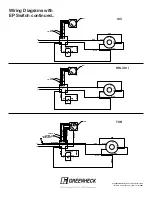
NO FLOW DUCT
SMOKE DETECTOR
Purpose/Application
National and local safety standards and codes recognize the
ability of air duct systems to transfer smoke, toxic gases, and
flame from area to area. Sometimes smoke can be of such
quantity as to be a serious hazard to life safety unless blowers
are shut down and dampers are actuated. The primary purpose
of duct smoke detection is to prevent injury, panic, and property
damage by reducing the spread (recirculation) of smoke. The
detector samples air currents passing through a duct and
gives dependable performance for management of smoke and
combination fire smoke dampers. Duct smoke detection can
also serve to protect the air conditioning system itself from fire
and smoke damage.
There are several important documents that provide guidance
concerning the performance, application and installation of duct
detectors:
1) NFPA Standard 90A,
Installation of Air Conditioning
and Ventilation Systems
2) NFPA Standard 92A,
Recommended Practice for
Smoke Control Systems
3) NFPA Standard 72,
National Fire Alarm Code
4) NFPA Standard 101,
Life Safety Code
5) UL Standard 268A,
Standard for Smoke Detectors for
Duct Applications
6) ASHRAE Handbook and Product Directory,
“Fire and
Smoke Control”
7) System Sensor,
Guide for Proper Use of Smoke
Detectors in Duct Applications.
Duct detectors are:
NOT
a substitute for an open area smoke detector
NOT
a substitute for early warning detection
NOT
a replacement for a building’s regular fire detection
system
Specifications
Type: Photoelectric
Air Duct Velocity: 0 to 3000 fpm (0 to 15.2 m/s)
Operating Temperature Range: 32°F to 120°F (0° to 49°C)
Operating Humidty Range: 10% to 93% RH
Operation Voltage: 120 VAC
Features
•
Designed for mounting on standard electrical box
• Low-profile smoke detector design
• Field adjustable sensitivity
• Built-in test switch
Listings
UL 268A
Refer to Greenheck Installation Supplement: Part # 465915- No
flow smoke detector IOM
#10 TEK SCREW
4 X 4 X 2 1/8 HANDI BOX
SMOKE DETECTOR ASSEMBLY






















